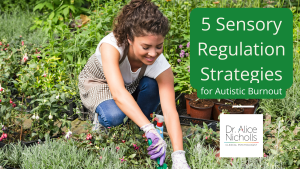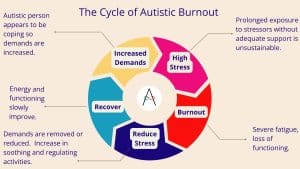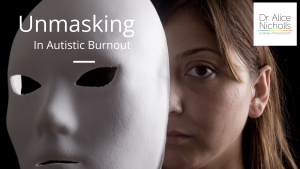There are three potential exit points in the cycle of Autistic Burnout.
In this article I will:
- Identify each of the three times it is possible to break free from the cycle of Autistic Burnout.
- Discuss the unique opportunities and challenges of these times.
- Give you tips for each of those stages.
Late realised, high masking Autistic people come to me at different stages in the cycle of Autistic Burnout.
I’ve learned that there are three key points in the cycle where it is easiest to make an exit.
These three key points are
- High Stress
- Increased Demands
- Recovery

High Stress
The benefit of trying to break the burnout cycle at this stage is that it is probably one of the easiest stages to identify there is a problem.
Normally the person feel highly stressed and are starting to experience some significant issues with their ability to carry out their usual activities.
By the time Autistic people get to this stage they are normally aware that they need to change something. The problem is what?
So often, by this stage, the stressors feel inescapable. The person may have been coping, or seen to to be coping with this level of demand for years, so there is limited understanding around how the status quo might be too much.
When people approach me in this stage they are often preoccupied with how to keep going or how to get back on track with all of the demands they are currently facing. The people around them might recognise they need help, but again, the focus is on getting the person to cope with a very high level of stress. A level of stress that simply isn’t sustainable.
If you have identified that you are currently in a highly stressed state and have started to notice warning signs of an impending Autistic Burnout it is not too late to avoid or at least minimise Autistic Burnout.
It can feel incredibly difficult to take a step back from a stressful situation, however, if you do not chose to do this in a way that suits you now, your body or mind might force you to do this later.
Things that may help in this stage are:
- Taking time off work on Annual leave as soon as possible.
- Taking time off work on sick leave for stress.
- Asking for a reduction in responsibilities at home or at work.
- Applying minimum standards to your work, home and family life.
- Resting when you can.
- Taking the type of rest you need, for example you may need to rest from social interaction but actually want to do some physical activity.
- Reducing Social Demands.
- Identifying and meeting any unmet sensory needs.
Increased Demands
This is a great stage to try and break out of the cycle of Autistic Burnout.
Energy levels and ability to think clearly are at their best.
Executive functioning skills are working reasonably well and so there is more capacity for thinking creatively about lifestyle and ways to reduce stress and increase soothing.
The difficulty is that generally, in this stage the Autistic person tends to be coping well. They may have more energy than usual and they may feel that they are thriving. When someone feels like this it is only through high levels of self awareness or looking at their historical patterns of burnout that they notice the trajectory they are on.
In this stage it can help to:
- Aim to save 40% of your energy each day.
- Notice the urge to say ‘yes’ to requests.
- Try to replace ‘yes’ with ‘can I let you know’ to give yourself longer to consider your response.
- Try to only take on activities and responsibilities that are essential or that you really want to do.
- Identify what a minimum standard would be in each area of your life and practice only doing that.
- Make sure you are scheduling in regulating and soothing activities throughout your days and weeks.
- Allow yourself extra buffer time around big events or periods of higher stress.
Recovery
The opportunity to leave the burnout cycle is greatest in the recovery phase. If your burnout has resulted in a reduction in responsibilities, demands and stressors then it is much easier to re-evaluate their place in your life and think creatively about what you need in order to live an authentic, energised and inspired life.
I find the biggest challenge in this phase is in realising that the pre-burnout level of stress was not sustainable and that it is not something to aspire to ‘get back to’.
Realising that a previous level of functioning was simply not sustainable can bring up feelings of grief and shame and activate a self-critical internal voice.
In this stage it can help to:
- Seek support from a neuroaffirmative therapist, autistic peers and online communities.
- Identify what your values are and think about how you could make your life more aligned with these.
- Consider how much you have been masking and think about ways you might reduce this.
- Try to develop a more compassionate and accepting way of talking to yourself.
- Identify and meet your sensory needs.
- Plan to include regular opportunities for rest and regulation throughout your days and weeks.
- Get in the habit of monitoring your energy levels and budgeting it so you don’t end up overspending.
Conclusion
There are multiple potential exit points in the cycle of Autistic Burnout. Each stage comes with its own unique opportunities and challenges.
Often by the time we notice we are highly stressed we can feel trapped and burnout can feel inevitable. If this happens to you, and you are unable to withdraw from stressors then please be kind to yourself. It’s not easy to break out of the cycle but it is possible and you are now more self-aware and more able to work out what you need for the future.











